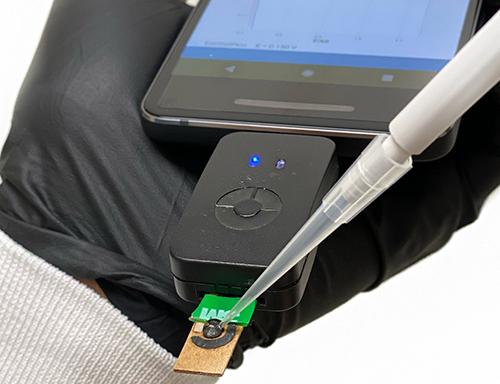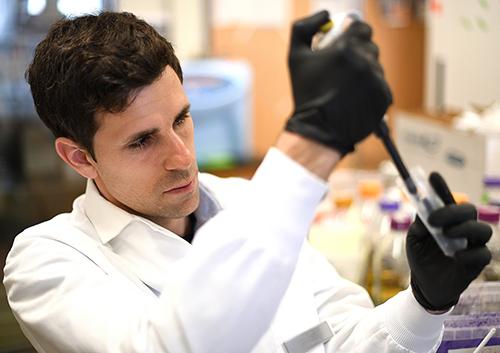The rapid diagnostic test costs less than $5 per unit and can be adapted for other diseases, the developers say, which opens a slew of possibilities for clinical laboratories
Just as the SARS-CoV-2 coronavirus spurred deployment of new vaccine technology based on messenger RNA (mRNA), the COVID-19 pandemic also could prove to be a watershed for in vitro diagnostics (IVD) innovation in ways that benefit clinical laboratories.
In one notable example, researchers at the Perelman School of Medicine University of Pennsylvania (Penn Medicine) in Philadelphia have developed a biosensor that uses electrochemical impedance spectroscopy (EIS) to detect the presence of the COVID-19 coronavirus in biological samples.
A Penn Medicine news release noted that “The RAPID technology … transforms the binding event between the SARS-CoV-2 viral spike protein and its receptor in the human body, the protein ACE2 (which provides the entry point for the coronavirus to hook into and infect human cells), into an electrical signal that clinicians and technicians can detect. That signal allows the test to discriminate between infected and healthy human samples. The signal can be read through a desktop instrument or a smartphone.”
Though still in its early stages, the technique potentially offers dramatically lower costs and faster results than traditional RT-PCR (reverse transcription polymerase chain reaction) molecular tests. Moreover, the RAPID technology might be useful for identifying other types of biomarkers and could be the basis for diagnostic tests that help reduce the cost-per-test in medical laboratory testing while providing comparable sensitivity and specificity to existing methodologies.
Clinical trials began on January 5, 2021, and the Penn Medicine researchers say the IVD test technology can be applied to other infectious diseases, which, if proven accurate, would be a boon to clinical laboratory testing.
The Penn Medicine researchers published their study on May 9 in the journal Matter, titled, “Low-Cost Biosensor for Rapid Detection of SARS-CoV-2 at the Point of Care.”
Diagnostic Test Results in Four Minutes for Less than $5/Test
According to the news release, the RAPID 1.0 (Real-time Accurate Portable Impedimetric Detection prototype 1.0) biosensor test costs less than $5 and can deliver results in four minutes. The researchers reported overall accuracy of 87.1% on (139) nasal swab samples and 90% on (50) saliva samples.
The technology uses electrodes that can be mass-produced at low cost on commercially-available screen printers, the researchers said. Results can be read on electronic devices connected to a PC or smartphone.

RAPID 1.0 (above) is a low-cost COVID-19 diagnostic test developed at the César de la Fuente clinical laboratory at the Perelman School of Medicine University of Pennsylvania in Philadelphia. At less than $5/test, plus the ability to be adapted to other diseases, clinical laboratories performing disease screenings in rural or remote locations may have a new tool in the fight against infections. (Photo copyright: University of Pennsylvania.)
Does Penn Medicine’s RAPID 1.0 Test Replace Traditional RT-PCR Testing?
In their published study, the Penn Medicine researchers cited the need for “fast, reliable, inexpensive, and scalable point-of-care diagnostics.”
RT-PCR tests, they said, “are limited by their requirement of a large laboratory space, high reagent costs, multistep sample preparation, and the potential for cross-contamination. Moreover, results usually take hours to days to become available.”
Researchers who have studied the SARS-CoV-2 coronavirus know that it uses a spike-like protein to bind to angiotensin-converting enzyme 2 (ACE2) receptors on the surfaces of human cells.
As described in Penn Medicine’s published study, the biosensor contains ACE2 and other biochemical agents anchored to an electrode. When the SARS-CoV-2 coronavirus attaches to the ACE2, the biosensor transforms the chemical reaction into an electrical signal that can be measured on a device known as a potentiostat.
The researchers tested their RAPID 1.0 technology with two commercially available potentiostat models:
- Squidstat Plus from Admiral Instruments, which connects to a PC, and
- Sensit Smart from PalmSens, which attaches to a smartphone.
The researchers initially developed the electrode as a printed circuit board, which is relatively expensive. To reduce costs, they constructed a version that uses filter paper as the main component. The researchers noted that one screen printer in a lab can produce 35,000 electrodes per day, including time needed to incorporate the chemical elements. “However, it must be noted that these steps can be fully automated into a production line for industrial purposes, drastically reducing time requirements,” they wrote.
The test can be performed at room temperature, they added, and total cost per unit is $4.67. Much of that—$4.50—is for functionalizing the ACE2 recognition agent. The cost for the bare electrode is just seven cents.
“The overall cost of RAPID may be further reduced through recombinant production of ACE2 and ACE2 variants,” the researchers said, adding that the RAPID 1.0 test can detect the SARS-CoV-2 coronavirus at low concentrations correlating to the earliest stages of the COVID-19 disease.

The Penn Medicine research team was led by César de la Fuente, PhD (above), an Assistant Professor in Psychiatry, Microbiology, Chemical and Biomolecular Engineering and Bioengineering at the Perelman School of Medicine. “Prior to the pandemic, our lab was working on diagnostics for bacterial infections,” he said in the Penn Medicine news release. “But then, COVID-19 hit. We felt a responsibility to use our expertise to help—and the diagnostic space was ripe for improvements.” (Photo copyright: University of Pennsylvania.)
Testing Penn Medicine’s RAPID 1.0 Test
The researchers evaluated the technology in blinded tests with clinical samples from the Hospital of the University of Pennsylvania. The evaluation included 139 nasal swab samples, of which 109 were determined to be COVID-19 positive by RT-PCR tests and clinical assessments. Among these, the RAPID test successfully detected the SARS-CoV-2 coronavirus in 91 samples, for a sensitivity rate of 83.5%. One sample was from a patient diagnosed with the highly contagious SARS-CoV-2 Alpha variant B.1.1.7, which the test correctly identified as positive.
Among the 30 samples determined to be COVID negative, the RAPID test scored a specificity rate of 100%, meaning no false positives. Overall accuracy, including sensitivity and specificity, was 87.1%.
The researchers also analyzed 50 saliva samples: 13 COVID-positive and 37 COVID-negative. The test correctly identified all 13 positive samples but produced five false-positives among the 37 negative samples, for a specificity rate of 86.5%. The researchers speculated that this could be due to interactions between ACE2 and other biomolecules in the saliva but suggested that performance “will improve when using fresh saliva samples at the point-of-care.”
Are There Other Applications for the RAPID Test?
The Penn Medicine news release said the RAPID technology can be adapted to detect other viruses, including those that cause Influenza and sexually-transmitted diseases.
Robert Michel, Editor-in-Chief of Dark Daily and its sister publication The Dark Report, said the test points to one silver lining in the COVID-19 pandemic. “Researchers around the world intensified their work to find ways to identify the SARS-CoV-2 virus that are faster, cheaper, and more accurate than the diagnostic technologies that existed at the time of the outbreak. In this regard, the COVID-19 pandemic may have accelerated the development and refinement of useful diagnostic technologies that will disrupt long-established methods of testing.”
Marcelo Der Torossian Torres, PhD, postdoctoral researcher at Penn Medicine and lead author of the study, said in the news release, “Quick and reliable tests like RAPID allow for high-frequency testing, which can help identify asymptomatic individuals who, once they learn they are infected, will stay home and decrease spread.
“We envision this type of test being able to be used at high-populated locations such as schools, airports, stadiums, companies—or even in one’s own home,” he added.
Clinical laboratory managers may want to stay current on the development and possible commercialization of the RAPID 1.0 (Real-time Accurate Portable Impedimetric Detection prototype 1.0) biosensor test by the research team at Penn Medicine.
—Stephen Beale
Related Information
Low-Cost Biosensor for Rapid Detection of SARS-CoV-2 at the Point of Care
Rapid COVID-19 Diagnostic Test Delivers Results within Four Minutes with 90% Accuracy
UPenn Medical School Develops Low Cost COVID-19 Test Called RAPID
UPenn Working on Rapid COVID Test That Delivers Results Within Minutes
Rapid COVID-19 Test Developed at Penn Could Give On-the-Spot Results Quickly


